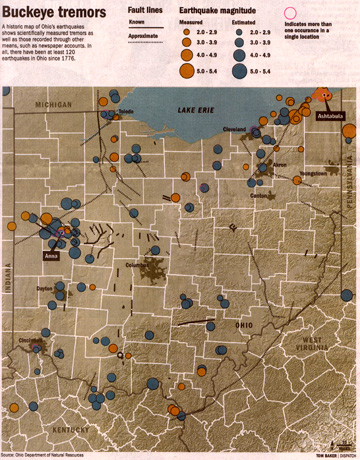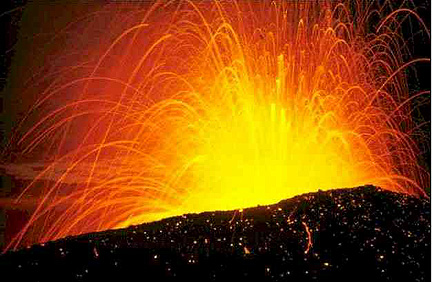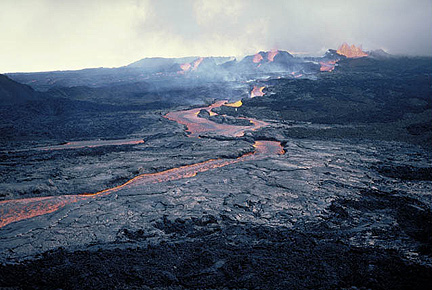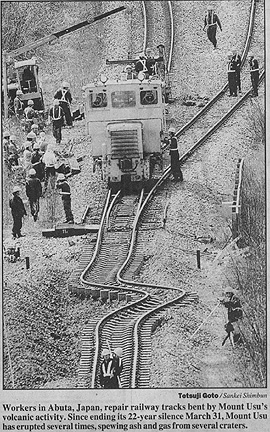
...to Geog 111 Main Page and Course Description
...to Geog 111 Syllabus
...to Geog 111 Course Schedule and Lecture Outlines
...to Geog 111 Course Project
Introduction
Review: Introduction to Landform Study
1. Earth and its Interior
2. Composition of the Earth's Crust
3. Additional Critical Concepts for Landform Study
4. The Process of Studying Landforms
Introduction: Internal Processes
Internal processes key to building terrain and landforms
1. Crustal Rearrangement
McKnight 13.23: Major Landform Assemblages
Assumption that the Earth's crust was rigid with continents and ocean basins fixed in place
This assumption has been replaced by various interrelated theories of tectonics
1a Plasticity
Plasticity: what is it?
Igneous rock in upper crust: two layers
McKnight fig 14.1: Continental vs Oceanic Crust
General crustal structure: characteristics
1b. Isostasy
Isostasy: what is it?
Effects when mass is added to or removed from the Earth's crust
Examples
McKnight 14.2: Isostatic Adjustment
Plasticity (horizontal movement) and isostasy (vertical movement) underpin the
concept of continental drift
1c. Continental Drift
McKnight fig. 14.3: Pangaea: greek for "whole land"
Alfred Wegener: proposed first comprehensive theory of continental drift in 1920s
As with many scientific theories: initial disbelief
1d. Plate Tectonics
Increasing understanding of lower, simatic (oceanic crust)
Sluggish thermal convection operates within earth: brings molten rock from deep in earth to the earth's surface; simultaneously pulls crustal rock into the depths and remelts it
McKnight 14.5: MidOceanic Ridges
1960s: Harry Hess: explaining ridges and trenches
McKnight 14.6: Seafloor Spreading
McKnight 14.6: Subduction
Evidence: age of ocean crust vs. continental crust
McKnight 14.7: Age of ocean floor
McKnight 14.8: Plate Boundaries
Lithosphere: mosaic of rigid plates (oceanic and continental crust)
Where continental plates meet...
1. Divergent Boundary: how defined
2. Convergent Boundary: how defined
3. Transform Boundary: how defined

McKnight fig 14.14: Breakup of Pangea
Animation) Continental Drift
Continental drift: dynamic movement of Earth's crust over time
Movement of Earth's crust results in many important earthly landform features:
All these landforms are explained by their location near where plates meet
Plate tectonics: young theory; new aspects of it being learned all the time
But some major earth landforms can't be explained with plate tectonics...yet
McKnight fig 14.16: Mantle Plumes or Hot Spots
McKnight fig 14.17: Hawaii Hot Spot
Change scale: look at more detailed (regional, local) scale of analysis
2. Vulcanism
Vulcanism: any phenomena connected to the origin and movement of molten rock
Vulcanism consists of:
2a. Volcanic Processes: Extrusive Vulcanism
Magma propelled onto earth's surface: lava
Quality of eruptions is driven by the content of the mineral silica in the lava
Higher quantity of silica: lava explosive when reaches earth's surface

Lower quantity of silica: lava non-explosive: Hawaii ooze


McKnight fig 14.19: World Volcanoes
About 550 active volcanoes in the world
About 50 in the US, mostly Alaska
Volcanic Landforms
1. Lava Flows
2. Volcanic Peaks
2a. Shield Volcanoes (fig 14.23b)
2b. Composite Volcanoes (fig 14.23d)
2c. Lava Domes (fig 14.23c)
2d. Cinder Cones (fig 14.23a)
3. Calderas
McKnight fig 14.25: Crater Lake, OR
McKnight fig 14.27
2b. Plutonic Processes: Intrusive Vulcanism
Magma solidifying below Earth's surface into igneous rock
Some gets pushed up into earth's crust before or after it cools
McKnight Fig. 14.31: Six typical Igneous Intrusions
1. Batholiths: subterranean igneous body of indefinite depth and enormous size
Raisz Map
2. Stocks: smaller version of a batholith
3. Laccoliths: slow-flowing magma forced between horizontal layers of existing rock
4. Dikes: vertical sheet of magma pushed up into vertical fractures in rock
5. Sill: long, thin intrusion of magma between layers of existing rock
6. Veins: smaller version of a dike
Sum so far: Internal Processes: building up landforms
1. Crustal Rearrangement: Earth's dynamic crust and the consequences
2. Vulcanism: origin and movement of molten rock
Next: the mangling of solid rocks in the Earth's crust
3. Diastrophism
Deformation of solid rock in the Earth's crust
Rock is bent or broken due to pressure from below
3a. Folding: solid rock gets bent
McKnight Fig 14.34
McKnight Fig 14.35: folding nomenclature
McKnight Fig 14.36: anticlinal valleys and synclinal ridges
WWW) Color Landforms Atlas of the US
3b. Faulting
Faulting: when rock breaks, and the rock on one or both sides of the break moves
McKnight fig 14.40: fault along sidewalk

Earthquakes
McKnight fig 14.41: fault scarps
Types of Faults
McKnight fig 14.42: fault scarps
Prominent Faulted Landforms
1. Horst: land uplifted between two parallel faults
3. Graben: reverse of a horst
4. Rift Valleys
Key issue: have to see how all of these internal processes
Internal Processes: building up landforms: Sum
1. Crustal Rearrangement: Earth's dynamic crust and the consequences
2. Vulcanism: origin and movement of molten rock
3. Diastrophism
3a. Folding: solid rock gets bent
3b. Faulting: crustal stresses also lead to rock being broken
4. The Complexes of Crustal Configuration
Next: Weathering and Mass Wasting: breaking down landforms created by tectonic forces
E-mail: jbkrygier@owu.edu
...to Geog 111 Main Page and Course Description
...to krygier teaching page.
...to krygier top page.